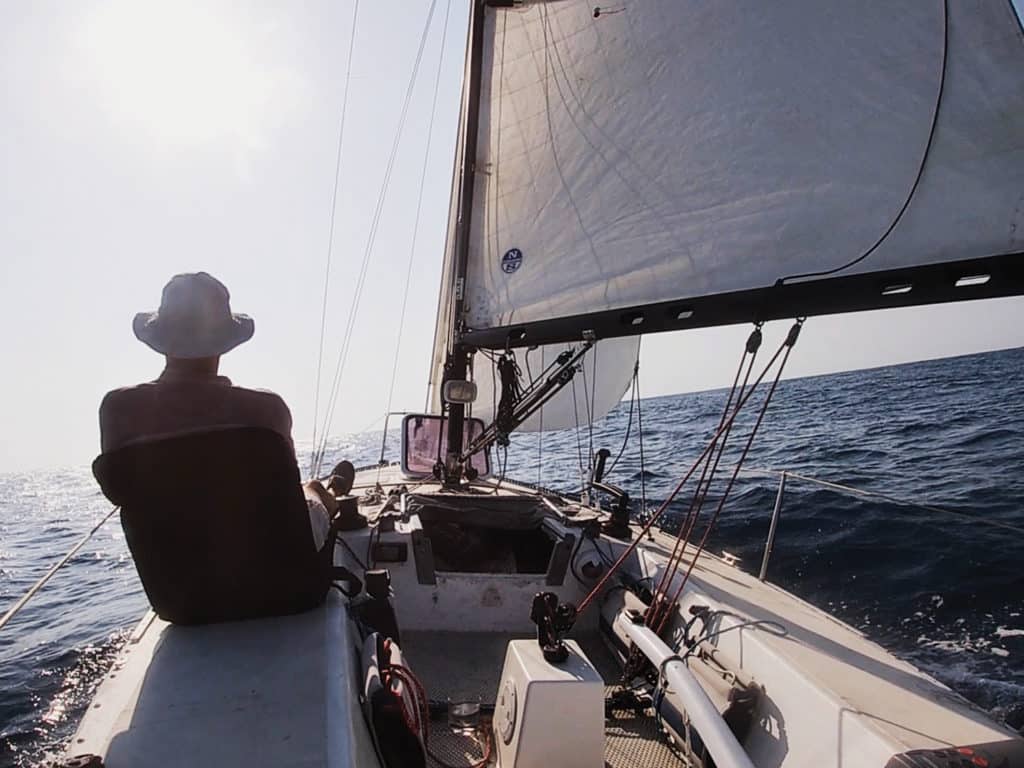
At 1930 on April 28, 2019, I hove to 9 miles west-southwest of San Diego’s Point Loma. Gannet, my ultralight Moore 24, had been there 30,000 miles and almost five years earlier. The setting sun was not visible through low overcast. Gray sky merely dimmed to black.
I sat in the cockpit as the northwest wind died, watching lights brighten along the shore. I felt a quiet sense of satisfaction—and some apprehension. We had sailed around the world, but we still had 9 miles to go, and I have been that close to ports before and taken days to get in.
At sea I receive no outside weather information, but earlier that afternoon, this close to land, I tried to turn on my handheld VHF to get NOAA weather. I found the battery dead, and it wouldn’t charge. On the little Sony receiver’s AM band, I caught a disturbing fragment of a forecast of 20 to 30 mph wind gusting 40, but I didn’t know where or when. On Gannet, the barometer had dropped 5 millibars in the preceding 36 hours. There was a low somewhere near.
I could see lights from Point Loma to Tijuana, Mexico.
I knew those lights. I have history along that coast going back more than 60 years, to the mid-1950s when my grandparents retired to a little cottage two houses in from the ocean at Mission Beach, a mile north of the roller coaster at Belmont Park, whose serpentine lights were clearly visible.
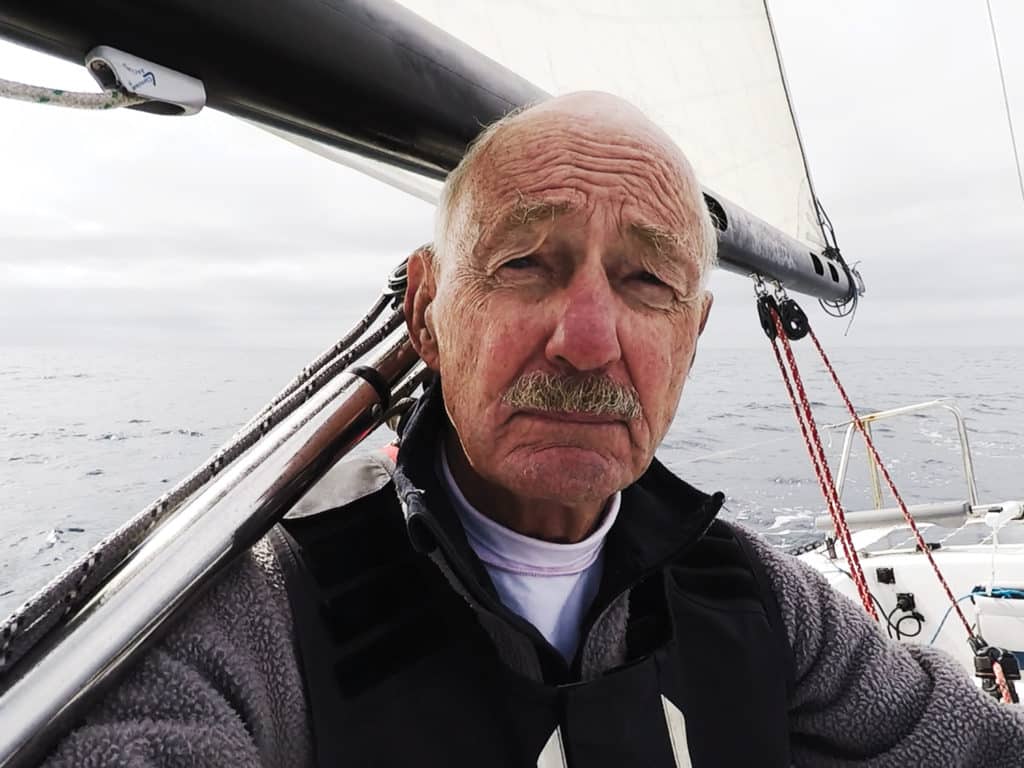
I had begun and ended my first circumnavigation in San Diego: two stops solo around Cape Horn in what was then-world-record time for a solo circumnavigation in a monohull. I’d launched my second in Chidiock Tichborne, an 18-foot open boat; I’d lived ashore and on boats in San Diego for many years, and had begun and was now about to end my sixth circumnavigation and what I have called the “being” part of my life there.
I knew exactly when the being part began: 1100 on Saturday, November 2, 1974, when, nine days short of my 33rd birthday, I pushed the engineless 37-foot cutter Egregious out of her slip at Harbor Island Marina for my first attempt at Cape Horn. Now at age 77, I could see a pleasing symmetry at ending that part of my life where it began.
Gannet’s bow was pointing west. On glassy water, she was as motionless as if anchored in a good harbor. I had only a can of Heineken to sip as I sat and considered what I had done during the being part of my life. I had made some voyages. I had put some words together. I had loved some women, which became singular when I met Carol 25 years ago.
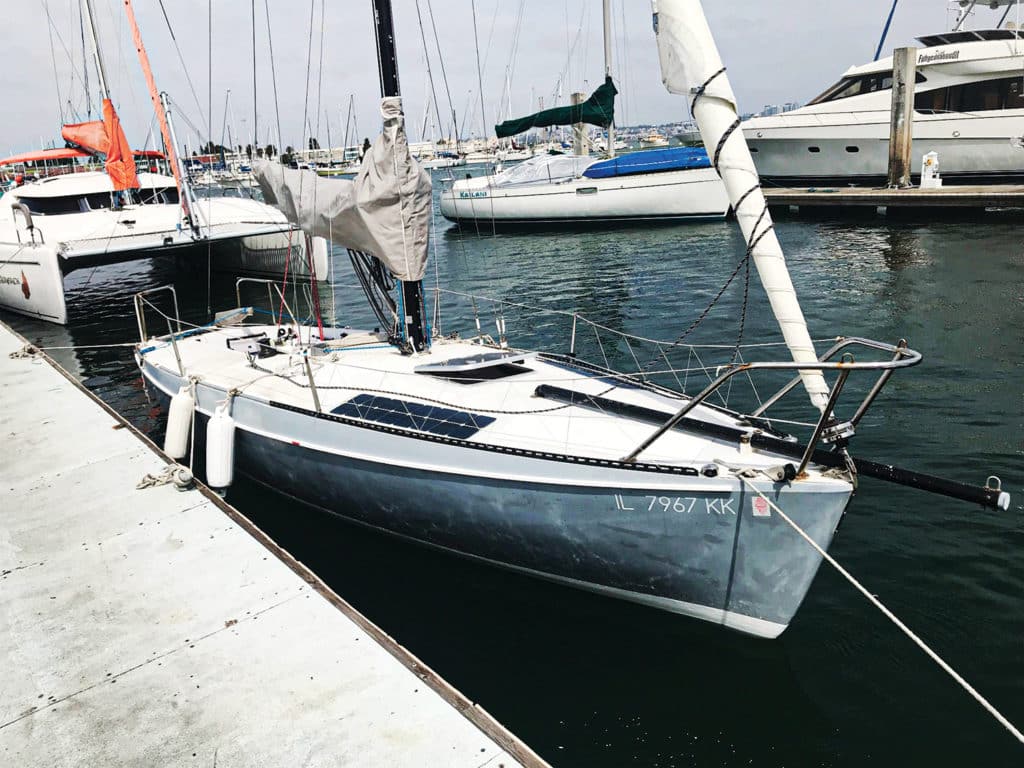
The can of Heineken was one of only three left after a slow and hard 45-day passage from Balboa, Panama, the hardest passage I could remember when there was no severe weather. We never had more than 25 knots of wind and perhaps no more than 20. My wind instruments had again died, so I could only estimate. Wine and spirits were long gone.
Of the six full weeks of the passage, five were the slowest weeks of the entire circumnavigation, interrupted only by the week crossing the Doldrums in the Atlantic Ocean two years earlier. I had expected light wind off Central America, but this exceeded my experience and even my imagination.
Gannet sails well in light wind, usually at or within a fraction of true wind speed, but that does not matter if the wind is only 1 or 2 knots—or zero, as it was for much of the first three weeks out of Panama. One day, our noon-to-noon run was 16 miles, by far Gannet’s worst ever. And I had the asymmetrical up part of that time. We would sail forward for two or three hours, then be becalmed for 19 or 20 hours and be carried back by current. Ten days after the 16-mile day, we had a 14-mile day.
The sun was almost directly overhead. With not a breath of breeze, the heat and my thirst were terrible. Usually I consume 0.37 gallon of fresh water a day. I left Balboa with 23 gallons on board, which should have been enough for 70 days. Yet when I had 3,000 miles to go and was making only 16 miles a day, I became worried about water. I could have drunk gallons. I wanted to drink gallons. But I permitted myself only sips.
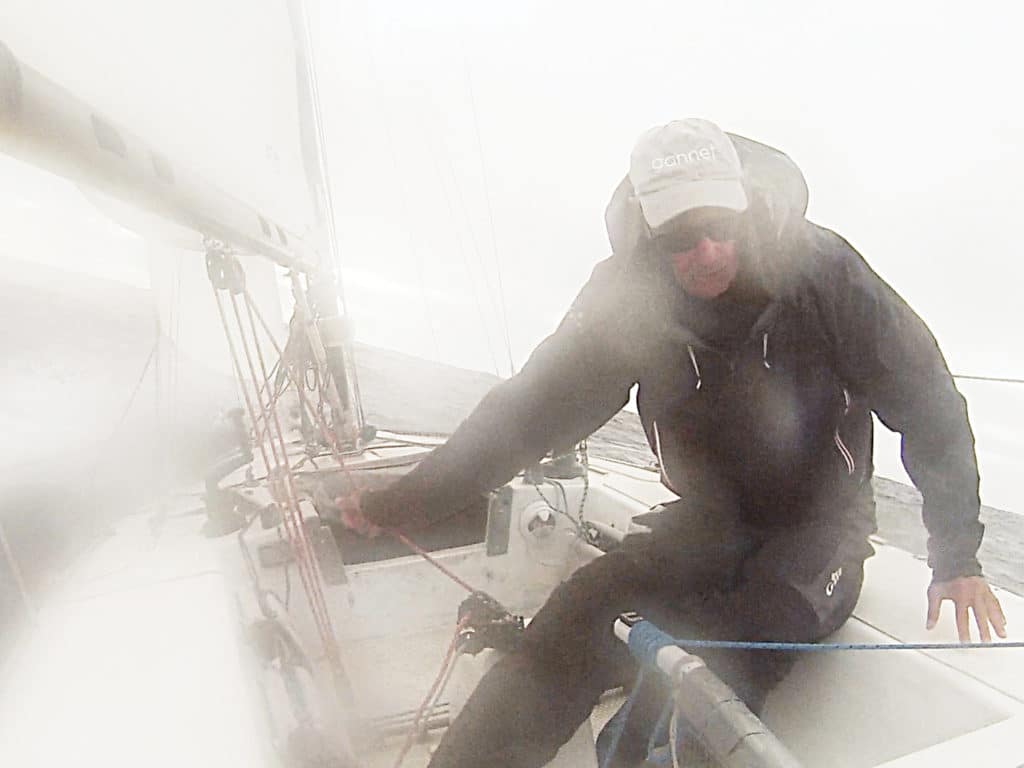
Even just sitting, rivers of sweat poured from me. Clothes were soaked within minutes, so I stopped wearing any. A battery-operated fan helped, but not much.
The sense of helpless frustration was as terrible as the thirst. Most afternoons there were two or three hours of wind, and every afternoon I hoped it would last, only to have it die away after sunset, leaving us drifting, sails down, all night.
For a while we were only 40 or 50 miles offshore, but this was not a land-breeze/sea-breeze phenomenon; the wind died even when we managed to get 200 miles from the coast.
Gannet slowly oozed her way northwest. When we finally found wind, it came from dead ahead. I had expected head winds the last 800 or 1,000 miles, but Gannet was hard on the wind the last 1,500. I did not complain. At least and at last we were sailing.
Until we reached the headwinds, I usually had a tiller pilot steering in wind too light for sheet-to-tiller. Most of the last 1,500 miles, we sailed to windward with the tiller tied down, which required frequent adjustments to changes in wind speed.
I worked hard. It’s my job. I certainly had nothing better to do. But I was very glad the passage was almost over. There were many times the first few weeks that I would have ended it if I could. I couldn’t, and having no choice, I struggled on. In the absence of joy, there is much to be said for honor and perseverance.
I looked north toward Mission Beach and tried to see the solitary teenage boy I once was sitting there watching boats sail by, thinking he would himself someday sail. I couldn’t. I could hardly remember him. He is long gone.
I took the last sip of beer and went below.
I fell asleep quickly on the port pipe berth.
I woke at 2200 and checked our position with a waypoint I put in when we hove to. Gannet had hardly moved. Standing in the companionway, I found Point Loma light where it had been two hours earlier. Out to sea were the running lights of three fishing boats. The wind was still calm. I went back to the pipe berth.
Two hours later, the world had changed. I woke to find dark sky, light rain and Gannet making 2 knots west. The wind was light and from the south, atypical in San Diego, and the direction it would blow on the forward edge of a low.
I got into my foul-weather gear, went on deck and headed us in, leaving the sails as they were: full main and deeply furled jib. We could go faster, but iNavX showed an ETA at a waypoint just off Point Loma of 0421. Sunrise was due at 0504. I did not want to be there before first light. Although California was on daylight time, I keep standard-zone time at sea. If the wind increased, I would set more sail and enter the harbor in the dark. That is no problem, but once inside, there are a lot of regulations about where you can anchor that are.
RELATED: Webb Chiles Completes Sixth Circumnavigation
Leaving my last working tiller pilot to steer, I went back below and sat and dozed at central, the position I usually sit on the floorboards facing aft. I set an alarm for 0200, but as usual woke before it went off, got up, glanced around, sat down again, and made myself a cup of instant coffee.
At 0300, the wind had increased and we were closing the land too quickly, so I lowered the main and continued under a scrap of jib. Forty-five minutes later, we were 3 miles off Point Loma, making 1.5 rolly knots. Running lights from two fishing boats were south of us, heading in too. I felt relief. Even if this became a storm, we were close enough to make port.
When the sky began to lighten behind inland mountains at 0430, Gannet was a half-mile due south of Point Loma, exactly where I wanted her to be. Ghostly white lines of desultory waves broke in shallows off the point. Ahead of us, the fishing boats had already made the turn north into the harbor, and as the day became brighter, I saw two boats motorsailing out, mainsails set. Although by then it was almost 0600 ashore, I thought that they were making an early start on a Monday morning.
We still had 3 miles to go to reach the police dock at the end of Shelter Island. I was in no rush and let the little boat glide slowly on. When Point Loma light was abeam, I spoke aloud: “That’s it. We’ve done it. Gannet is a great boat.”
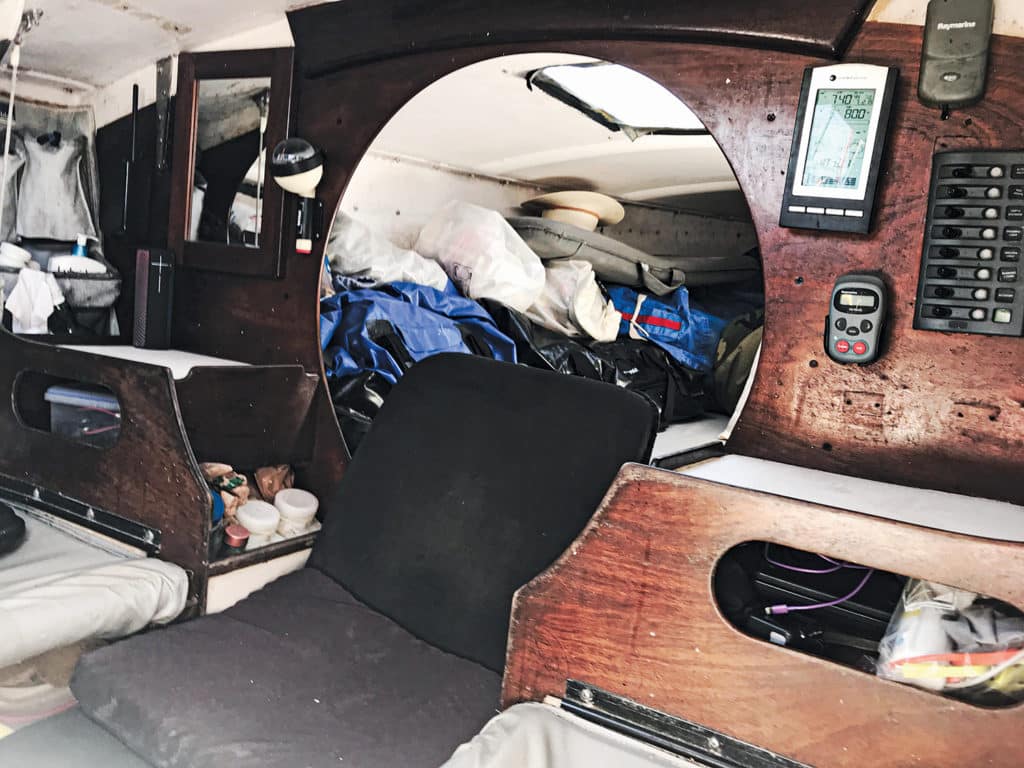
I was close enough to have cellphone coverage and got a weather forecast. Wherever the 20 to 30 mph wind was, it was not San Diego, which was predicted to have only a normal 12 knots that afternoon.
Earlier I had dragged the Torqeedo, dock lines and fenders from where they are stowed during passages, aft of the port pipe berth, into the great cabin. As the water smoothed in the bay, I fit them. Once I had determined that the Torqeedo started as it should, I turned it off. We were making 2.5 to 3 knots under furled jib alone, which is as fast as I usually power with the electric outboard.
The bay became busy. Several more sailboats were motoring out, as were sport-fishing boats and small powerboats. Behind us, a tug was towing a barge, and a big Navy ship was entering the channel. I turned Gannet to get clear to the west, just outside the channel. I hadn’t seen such activity since leaving Balboa.
Glancing aft, I found a long piece of kelp, the bane of San Diego sailing, caught on the Torqeedo. I ducked below for the boat hook and managed to remove it.
A hundred yards off Shelter Island, I turned on the Torqeedo and furled the jib. We had sailed off the mooring at the Balboa Yacht Club. This was the first time the Torqeedo had been used during the passage.
As I powered slowly toward the dock, I saw a sign that it is now called the Customs and Border Patrol Dock. I was surprised at the activity. Two-thirds of the long dock was occupied by sailboats, and several more were circling. I had chanced to reach San Diego just as hundreds of boats were clearing in on their return from the Ensenada Race.
Three figures near an empty space waved as I made a U-turn into the wind. I recognized one as Susan, an old friend. The other two, Lee and Rob, were to become new friends. All had been following the Yellowbrick track and came down to see Gannet arrive. I had not expected anyone and was appreciative. They took my dock lines.
Gannet’s motion is so fast that after a passage, the land still moves. That has never happened to me before on any other boat. On wobbly legs, I stepped onto the dock. There was only a moment to realize that the passage and being part of my life were truly over. Full understanding would come with time.
Webb Chiles is a sailor, author and now a six-time solo circumnavigator, whose voyages have been made on an eclectic collection of sailboats.








